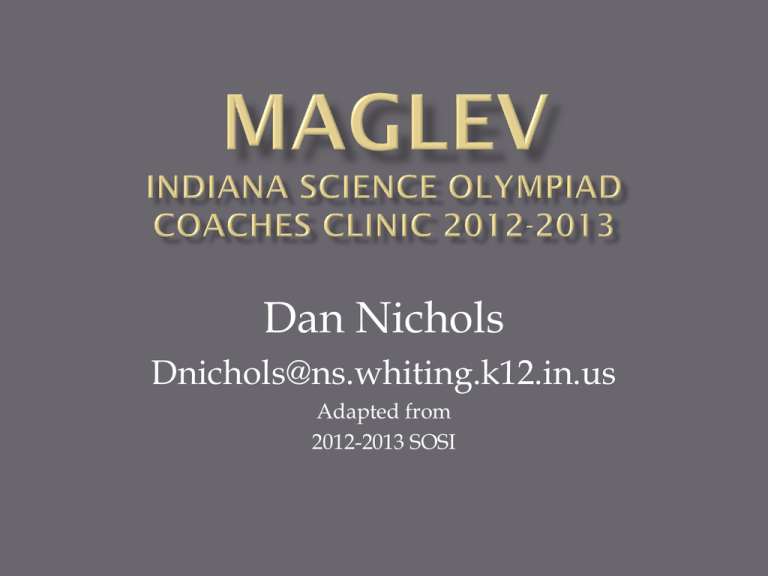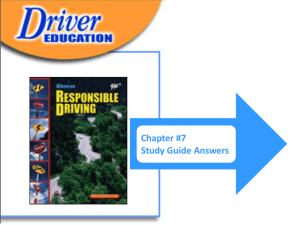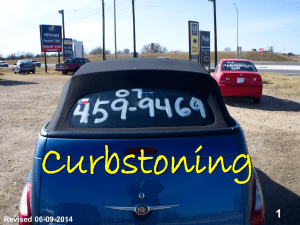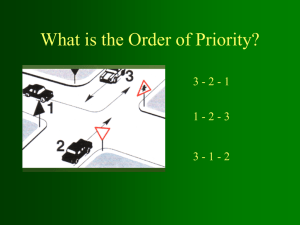MagLev-2 - HAST 11th Grade Portal
advertisement

Dan Nichols Dnichols@ns.whiting.k12.in.us Adapted from 2012-2013 SOSI This event has two parts: Part 1 vehicle testing and Part 2 written test on magnetism concepts For Part 1: the vehicle(s) and any material needed to adjust the vehicle must be impounded prior to the start of competition Teams may bring their own track or use the supervisor provided track. Teams may share tracks but must have different vehicles. Tools and track do not have to be impounded, but the supervisor needs to check the track for specifications before use. Z87+ high impact goggles must be worn by competitors during set-up and testing. Students build up to two self-propelled magnetically-levitated vehicles to move down a magnetic track. Main Goal: Consistency Maximum Voltage of Any Circuit: 9.0 V as calculated by their labels Vehicle size restrictions: length between 15 and 20 cm; height < 20 cm, excluding the dowel; width must fit a standard track (width of 2 9/16”) Students run their cars and develop data charts and graphs of the time it takes for their car(s) to travel between 50 and 95 cm This data will be used to help predict a time score during the competition. Must be between 15.0 and 20.0 cm long Must have a height less than 20 cm (excluding dowel) Mass must be no less than 150.0 g Car must fit on standard Mag Lev track (see next slide) No part of the vehicle, other than the propeller, may extend outside of the vertical planes of the track No rare earth magnets (can damage magnetic tape in the track) Car must have a 30 cm long 1/8” dowel vertically attached within 5 cm of its front edge or be able to accommodate the supervisors dowel Vehicles may have up to 2 propellers and two motors. Motors must fit specifications in rules. Car must remain levitated throughout run Track length must be at least five feet in length. Longer tracks are allowed, but only a five foot section will be used for competition. Side rail height can be between 2.0 cm and 5.0 cm. Teams can bring their own sled and track and use them, as long as the supervisor verifies the track dimensions (width, length, etc.), similar to the ramp in gravity vehicle. This home-built track was used at the 2012 national tournament at a total cost of less than $30 and was not damaged in transport from Wisconsin to Florida via UPS. Track is only five feet long…easier for transport and storage Don’t mind the slight crookedness…this was fixed after the picture was taken. The side walls should be perpendicular with the track. The instruction manual for creating this track will be available on the Mag-Lev page on the national website Teams will have 8 minutes to predict the time of their vehicle(s), then orient their vehicles appropriately, adjust and repair their vehicle(s) and make two successful runs on the track Competitors must place their vehicle on the track directly before the start line of the timed portion. A pencil is used to hold it in place. Competitors will indicate when they are ready and turn on their motors. Vehicles are not allowed to be touched once the motors are turned on. The supervisor will give a “3, 2, 1, launch” the competitor must the release the vehicle by removing the the pencil and stepping away from the track. Teams may use the same car for both runs or elect to use a different vehicle for the second run, but they may not change the predicted time. If the car does not move in 3 seconds or the vehicle does not travel the entire distance, the team is allowed to restart without penalty as many times as possible in the 8 minute time frame. Vernier photogates were used with lasers. There is also a written test on magnetism. Topics to be covered include: Polarity Earth’s Magnetic Fields Electromagnetic principles Magnetic vs. non-magnetic materials Common uses of magnets Historical Development of Magnetic Theory & Technology Superconducting MagLev Transportation Technology Magnetic Force Electric Motors and Generators Solenoids Magnetic Domains Permenant magnets Ferromagnetic materials Medical uses of magnets and superconductors A common concern is the cost of this event Many schools already have Mag-Lev tracks My school in Wisconsin had one in our old Technology Education room that met specifications. A neighboring school has three tracks that all met specifications. The cost of making a track can be shared with the Science and/or Technology Education Department I use my track in Physical Science and AP Physics B classes Instructions for making a track to meet all specifications for less than $30 are available on the national website. One of these tracks were used at the National Tournament in 2012. Successful cars can be made inexpensively The car that was the WI Div C state champion in 2011 only cost $9.50 for the parts not including two 9V batteries. Students can be very creative and build a successful cheap car! One common concern with this event is that too many cars get “stuck” in the track and can’t travel down the entire distance…the following modifications were made to last year’s trial rules: Students have 8 minutes instead of 5 minutes Students can bring and impound their own track and sled to use, after verification by supervisor Students are given an ideal time and adjust their sled mass, allowing teams to get down the track and get in Tier 1 even with very light sleds Make sure your students closely investigate why their vehicle stops in the track. Is the car really stuck due to a width issue, or is the car twisting in the track? Is their motor/battery/propeller combination too weak, not giving their car enough thrust to overcome some friction on the side walls? Is the car’s center of mass too high and the stability of the vehicle low during its run, causing it to tip over? The most successful teams in this event know their cars, how to modify them, and understand how balance, torque, and center of gravity are all related on their specific car(s). Great website from New York, but beware of the rules changes for 2013: http://newyorkscioly.org/SOPages/COTResources.html Many resources will be posted on the National www.soinc.org website as well, including a sample scoring worksheet and EXCEL spreadsheet for use by event supervisors to compute team scores and an impound checklist.











